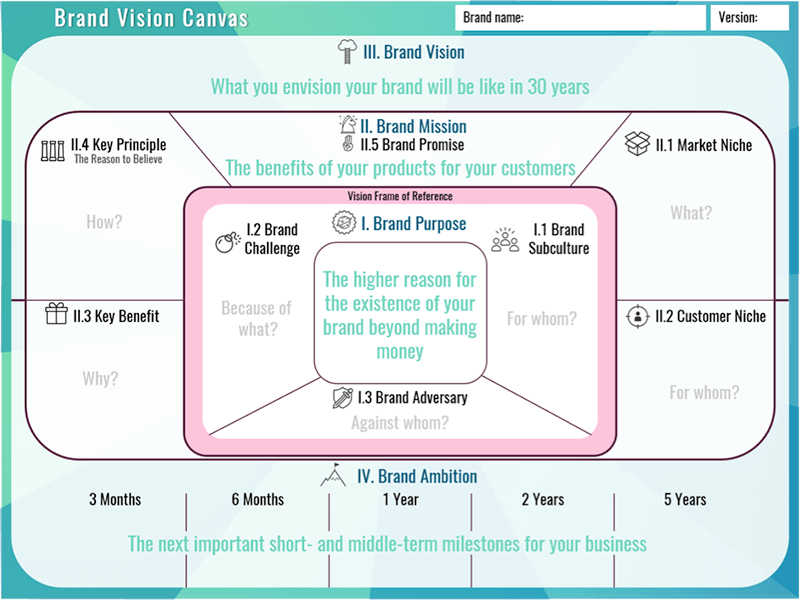By Klaus Heine and Sabine Chrétien-Ichikawa
Especially in times of economic turbulence, companies need to be even more innovative. But competition has shifted from product innovations and functional benefits to cultural innovations and symbolic benefits. About two-thirds of consumers want companies to stand up for social or environmental issues they also feel passionate about (Accenture 2018). Conscientious consumers may buy or boycott a brand because of its social or political stance. Along with this trend, a growing number of companies engage in Brand Activism, to drive social, political, or environmental change. This explains why everyone seems to be talking about purpose today, along with CSR, sustainability, eco, and ethical branding. Purpose-driven branding is probably one of the key business success drivers today – but it comes with some substantial risks and challenges.
The Brand Purpose is part of the overall company objectives, which are known to be closely related to company success. Shang Xia, a Chinese high-end lifestyle brand owned by Hermès, recently celebrated its ten-year anniversary in Beijing. At this occasion, one of the authors of this article interviewed Mrs. Qionger Jiang, the head of Shang Xia and Mr. Patrick Thomas, the president of Hermès at the time when the brand was launched. The goal of the interview was to ask them to look back at the last ten years and think about the key factors that made Shang Xia successful. Mr. Thomas replied that the ultimate success factor is to have a clear Brand Vision: “You need to know exactly what you want. As soon as you divert from that, you are losing strength. Every decision and every act of the company has to be in harmony with the vision” (Heine 2020). The Brand Vision inspires and motivates entrepreneurs and staff to keep going and attracts like-minded customers to the brand. Mrs. Jiang further explained that all senior managers must share exactly the same vision. And as this was the case at Shang Xia, there were never any serious disputes about the strategic direction of the brand between Mrs. Jiang and Mr. Thomas.
As part of the Brand Vision, the Brand Purpose refers to a “good cause.” However, when we look at studies about customers’ willingness to pay more money for fair-trade, bio, or environment-friendly products, the results are often quite disappointing for many entrepreneurs. Many idealists are surprised that most people are simply not willing to just hand over more money so they can “do good.” While ‘helping children in developing countries’ or ‘saving the rain forest’ are important issues, they are pretty far away from the small world around us. For too general causes, people tend to pay lip-service instead of a price premium. Having a clear brand purpose isn’t enough on its own. We should never forget about a fundamental marketing lesson that is rooted in human nature: People spend their money depending on the value that they believe to receive in return.
To harness the power of brand purpose, we need to understand, first of all, the differences between the different types of brand objectives: Brand Purpose/Mission/Vision/Ambition – which are often confused. Second, to really drive your business, we need to connect the Brand Purpose with a strong Brand Mission.
Let’s start by looking at a few examples of Brand Purpose/Mission/Vision/Ambition. Do you know what is what?
- Coach: To become a company that defines global modern luxury
- Stella McCartney: To achieve good environmental and especially animal welfare standards
- Warby Parker: To offer designer eyewear for fashion-conscious Millennials at a revolutionary price by cutting out the middleman and selling directly to our clients.
- Shang Xia: In 2021, we plan to open three new stores in China.
As it’s the most descriptive and established term, “Brand Vision” was selected to describe the entire category of overall business objectives. The Brand Vision Canvas (see Figure below) helps you to identify and to illustrate your Brand Purpose/Mission/Vision/Ambition in a comprehensive overview. All of them are long-term business objectives – but they differ by the time horizon and by whom they address – the society, customers, or the company.
Brand Purpose:
Think about the higher reason for the existence of your brand beyond making money. The Brand Purpose is not about creating customer value, but about ‘doing good’ for the environment or society. Inspired leaders and brands don’t describe ‘what’ they do – they think, act, and communicate from the inside out – they start with ‘why.’ Because according to Sinek (2009), “People don’t buy what you do; they buy why you do it. And what you do simply proves what you believe.” A typical example is the statement of Stella McCartney above. The purpose of Shang Xia is to revive the pride of the Chinese people in their heritage.
Brand Mission:
Think about the benefits of your products for your customers. Once you know ‘why’ you do what you do, the question is ‘how’ are you going to do it? The Brand Mission captures your brand’s unique value proposition that customers can obtain through all the products under your brand. As shown by the example of Warby Parker above, you can draft a Brand Mission by the following formula: [Our brand] provides [what?] for [whom?] who seek [why?] and who prefer our products because [how?]. Shang Xia provides fine apparel, leather goods, jewellery, tableware, and furniture for demanding clients who seek a combination of superior quality, contemporary design, and Chinese tradition and who prefer their products because they are hand-crafted by the very best artisans.
Brand Vision:
Think about what you envision your brand will be like in, for instance, 30 years. The Brand Vision reflects the ultimate long-term goals for your company – something that will require significant change and progress to attain. An example is the statement by Coach. The long-term vision of Mrs. Jiang for her brand is to develop Shang Xia into the Hermès of China.
Brand Ambition:
Think about the next important milestones for your business. To know how successful you are and to really motivate your people, you need to break your vision down into manageable chunks. Just like the example by Shang Xia above, Brand ambitions include clear goals and key performance indicators for the next months and years.

Let’s now look into the second point with a few examples. Fashion label ‘Life is Good’ doesn’t care much about clothing, but about their message – to spread optimism. The Brand Purpose of Dove is women empowerment, to encourage women to have a positive body image. Dove appears as qualified in this pursuit because it fits perfectly with their personal care products. Patagonia stands up for the conservation of resources, which is also closely linked to their products – with their efforts in product durability, repair services, and recycling.
What do successful brands such as ‘Life is Good’, Dove, and Patagonia have in common? They are all driven by a powerful Brand Purpose — which relies on a strong Mission. In fact, their products appear to be an extension and expression of their Brand Purpose. ‘Life is Good’ t-shirts are just a means to achieve a higher purpose: To spread the power of optimism to the world. Consumers are not spending their money for Dove products because they do some charity. Their cream makes customers feel more self-confident and beautiful the way they are — and with each cream they buy, they make a little step towards the brand’s higher purpose of women empowerment. Patagonia offers high-quality jackets made from recycled materials. While consumers purchase them because they like the quality and longevity, they help the brand at the same time to pursue its purpose, which is to reduce the human impact on the environment.
Mrs. Jiang and Mr. Thomas explained that their Brand Mission and unique selling proposition rely on three principles including their strong style & creativity, the product quality & excellence of craftsmanship, and the Chinese touch, which means that each product embodies a cultural story from Chinese history or traditions. Their customers enjoy buying some appealing products for themselves, while at the same time, they support Shang Xia’s purpose to revive centuries-old Chinese cultural traditions.
These examples show that to drive business success, a purpose-driven brand (that aims to save nature, etc.) must be linked to a compelling Brand Mission (a unique selling proposition) because, first of all, people want to know what the product can do for them. Based on that, they are ready to learn more about the brand’s higher purpose, which can satisfy higher-order consumer needs and greatly improve brand-consumer ties and business success.
Especially in the luxury segment, companies try to provide consumers with a good excuse for indulgence. Some consumers feel they shouldn’t make luxury purchases due to changing social norms especially in times of economic recession. The best justification for indulgence is a sense that they’re actually contributing to something larger than themselves, which can create a deeper sense of partnership between the consumers and the brand. The more money people spend for some desirable benefits, the more they also (can say to themselves and others to) support some higher purpose.
Shang Xia and the other examples teach us some critical success factors, which are summarized in the following major lessons learned:
- The Brand Purpose must be specific, yet simple: A clear, simple and consistent purpose strengthens the brand in consumers’ minds. Therefore, everyone inside the company must be able to articulate clearly why the brand is doing what it’s doing. The Brand Purpose must also be very specific – unlike the vague purpose of outdoor apparel maker Lost Arrow Corporation: “To be a role model and a tool for social change.” Too many brands could say the same.
- The Brand Purpose should be closely linked to your products: When developing a brand’s purpose, it can be tempting to pick a popular issue. Multiple brands have received backlash for lecturing their customers on unrelated topics, such as Audi over equal pay. But if brand managers are not honest about what inspires them or jump on a social cause that is unrelated to their brand DNA, their brand will appear inauthentic and confusing.
- The Brand Purpose must be credible: Everything you say and everything you do has to be in line with your Brand Purpose. Therefore, it is recommended to turn the purpose into a benchmark question, to encourage everyone in the company to continually question what they are doing: “What are you doing today to [Think different] or [Spread optimism]?”
- A strong brand needs a common enemy: Many entrepreneurs try to please all possible consumers all the time – but in the end, they stand for nothing. Strong brands are like good books, songs, and art – they have their own point of view. As Stella McCartney started to fight for animal rights in fashion, she met with tough resistance. According to communication specialist Kasi Bruno (2017), “The best brand stories repel more people than they attract. Simultaneously magnetic and uncomfortable, strong brand narratives act as a rallying cry for some, but as a snub for most.”
- Never compromise on your Brand Vision: At the beginning when Shang Xia was launched, out of 100 products, only about ten met their extreme quality standards and so they had to destroy the rest. This was a difficult decision to make (which would probably be heavily criticized today because of environmental concern).
- Think big, start small: A Brand Vision should stretch the imagination and challenge yourself and your team to grow. But with your Brand Ambitions, start small. Instead of pushing brand communications too early, better fine-tune your offerings and revise your branding strategy by trial and error until you can seduce a small number of core clients. For instance, Uber tested and fine-tuned its business model in San Francisco, then expanded rapidly. Accordingly, you can focus on a single city, area, or customer sub-segment at first.
- A Vision must always be alive: Based on his experience as the president of Hermès, Mr. Thomas has learned a key lesson: Many strategic problems arise from a lack of vision – or the fact that the vision became obsolete. Therefore, a vision should never make a sudden 180-degree turn but, on the other hand, must always be adjusted gradually.
This article highlights a unique collaboration between a European luxury group and a Chinese designer. The support of the established Hermès Group enabled the new brand to benefit from strong branding skills and expertise, and a long-term vision, from its inception. In the near future, Chinese brands are likely to gain momentum, inventing new ways to create brand value.. Even though the high-end segment is the most difficult one for China to gain legitimacy, and the concept of purpose is not common yet, forward looking entrepreneurs and demanding consumers may take the world by surprise.
This article was originally published on April 2, 2021.
About the Authors

Klaus Heine works as marketing professor at Emlyon Business School in Shanghai and Paris and helps entrepreneurs to build high-end brands with a higher purpose. He runs the “High-end Brand Management” Master program and has worked and cooperated with Hermès, Dior, Louis Vuitton, Montblanc and many other brands.

Sabine Chrétien-Ichikawa is a French researcher based in Shanghai since 2012. After working in the fashion and luxury industries in several countries, she now runs the MSc in EU-Asia Luxury Marketing program at ESSCA School of Management in Shanghai. Her expertise includes luxury / high-end brand management, retail and sustainability.
Sources:
- Accenture (2018) From Me to We: The Rise of the Purpose-led Brand, https://www.accenture.com/_acnmedia/thought-leadership-assets/pdf/accenture-competitiveagility-gcpr-pov.pdf (accessed on 6 January 2021).
- Bruno, K. cited by Klaas, K. (2017) Telling Stories: How to Write a Vision Statement for Your Company; https://gusto.com/blog/start-business/how-to-write-a-vision-statement-for-your-company.
- Bonchek, M. & France, C. (2018) How Marketers Can Connect Profit and Purpose. Harvard Business Review, June 18, https://hbr.org/2018/06/how-marketers-can-connect-profit-and-purpose (accessed on 6 January 2021).
- Heine, K. (2020) Build a Brand to Change your World: A Step-by-Step How-to Guide to Build a High-end Brand with a Higher Purpose, Upmarkit: Tallinn, https://upmarkit.com/how-to-build-a-brand-to-change-your-world.
- Sinek, S. (2009) Start with Why: How great Leaders inspire everyone to take Action, Penguin: New York.





























